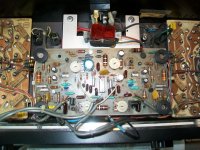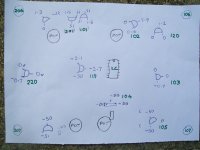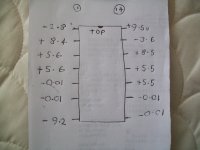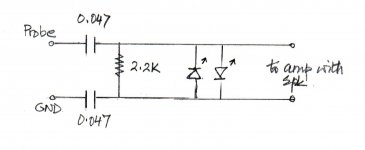Good morning gentlemen,i wonder if some of you could assist with this project..i know these DC300a's have been covered before,but i cant find anything relating to my problem in those threads...i have a DC300a here, circa 1973/74,With an issue...no sound! i have recapped the main board, checked every transistor and diode,checked every resistor (and replaced some out-of value ones where required)...have fitted a new 739 ic,but still the same problem.
Powers up, have 0.00v and 0.01v DC on outputs,so all ok there. I have the correct voltages at the diode pump (90v) But no audio.
I have sent the voltages i am getting on the main board,clearly Q120,Q102,Q220 and Q103 are incorrect.
On the chip,i should be getting 1.35v at pin 1,but i have -2.8v,so something is clearly amiss with this board. I have checked the pcb tracks carefully,there are no breaks or cracks. but now i'm stuck....would appreciate any advise on where to look now.
Powers up, have 0.00v and 0.01v DC on outputs,so all ok there. I have the correct voltages at the diode pump (90v) But no audio.
I have sent the voltages i am getting on the main board,clearly Q120,Q102,Q220 and Q103 are incorrect.
On the chip,i should be getting 1.35v at pin 1,but i have -2.8v,so something is clearly amiss with this board. I have checked the pcb tracks carefully,there are no breaks or cracks. but now i'm stuck....would appreciate any advise on where to look now.
Attachments
Last edited:
Thanks Jon,yup,is the first one of those Schematics....blow it up,says +1.35v....but im getting -2.8v there. Not right.
So what are you getting on 5 & 6? also 9,8. Usually op amps all three pins should be about the same DC value with no sound.
So with no speaker attached adjust R103 & R203 to get +1.35 out of 1 & 13. Then see what DC voltage the speaker + jacks are at.
If not within 200 mv of zero, something else is wrong.
You can track sound through the amp with a scope, a sound probe, or my favorite, an analog voltmeter with 50 or 20 vdc and 10 or 2 vdc scales. Used scopes are full of electrolytic caps that are expired already and new ones will in 20 years. Sound probes are another amp & speaker with a DC protector on the front end. DC protector is two .047 caps, in & gnd, followed by 2.2 k resistor both legs. Then cross the legs with back to back red LED's to clamp the voltage in to 2. the two wires to to hot & ground of an amp.
AC VOM can be bought for as low as $18 on ebay. put a .047 uf >200 v cap in series with the negative lead, they will read DC on AC scales without. Use clip leads, you shouldn't be touching the two probes with both hands anyway. Voltage over 24 from one hand to the other can stop your heart. Also wear no jewelry hands or neck, 1 v @ 50 amps can burn your flesh to charcoal. Also wear safety glasses, transistors explode, solder splashes.
So exercise the amp with a portable radio earphone jack, which you've checked with the earphone to make sure it is on station & putting out music. Then change to 1/8" stereo phone plug to dual RCA plug adapter (or 1/4 phone plugs). If radio is on a rock station, you'll see the beats of the music on the pointer. High steady AC voltage is often ultrasonic oscillation.
Oscillation is the reason I don't recommend a RMS DVM. The fluke one tops out at 7 khz, will read ultrasonic oscillation are zero volts. Cheaper DVM lie a lot on music, they only are supposed to report 50-60 hz.
So check at pin 5 and 9 to see if the music is getting in. Then follow on from there.
Have fun. Let me say I wouldn't use a DC300 or *a on any speaker over $10, without a series 3300 uf 50 VNP cap, or an audio transformer, to remove any DC caused by pot 103/203 losing contact with the wiper. Cheapest way to get an audio transformer is a used architectural amp like a MMA-875 or MMA-8150, I just bought 2 for $70 each delivered. The MMA-875t had a bad solder joint stopping sound & was unused, the MMA-81502 had nothing wrong with it.
So with no speaker attached adjust R103 & R203 to get +1.35 out of 1 & 13. Then see what DC voltage the speaker + jacks are at.
If not within 200 mv of zero, something else is wrong.
You can track sound through the amp with a scope, a sound probe, or my favorite, an analog voltmeter with 50 or 20 vdc and 10 or 2 vdc scales. Used scopes are full of electrolytic caps that are expired already and new ones will in 20 years. Sound probes are another amp & speaker with a DC protector on the front end. DC protector is two .047 caps, in & gnd, followed by 2.2 k resistor both legs. Then cross the legs with back to back red LED's to clamp the voltage in to 2. the two wires to to hot & ground of an amp.
AC VOM can be bought for as low as $18 on ebay. put a .047 uf >200 v cap in series with the negative lead, they will read DC on AC scales without. Use clip leads, you shouldn't be touching the two probes with both hands anyway. Voltage over 24 from one hand to the other can stop your heart. Also wear no jewelry hands or neck, 1 v @ 50 amps can burn your flesh to charcoal. Also wear safety glasses, transistors explode, solder splashes.
So exercise the amp with a portable radio earphone jack, which you've checked with the earphone to make sure it is on station & putting out music. Then change to 1/8" stereo phone plug to dual RCA plug adapter (or 1/4 phone plugs). If radio is on a rock station, you'll see the beats of the music on the pointer. High steady AC voltage is often ultrasonic oscillation.
Oscillation is the reason I don't recommend a RMS DVM. The fluke one tops out at 7 khz, will read ultrasonic oscillation are zero volts. Cheaper DVM lie a lot on music, they only are supposed to report 50-60 hz.
So check at pin 5 and 9 to see if the music is getting in. Then follow on from there.
Have fun. Let me say I wouldn't use a DC300 or *a on any speaker over $10, without a series 3300 uf 50 VNP cap, or an audio transformer, to remove any DC caused by pot 103/203 losing contact with the wiper. Cheapest way to get an audio transformer is a used architectural amp like a MMA-875 or MMA-8150, I just bought 2 for $70 each delivered. The MMA-875t had a bad solder joint stopping sound & was unused, the MMA-81502 had nothing wrong with it.
Last edited:
Also wear no jewelry hands or neck, 1 v @ 50 amps can burn your flesh to charcoal. Also wear safety glasses, transistors explode, solder splashes.
Very practical advice!
I've had first hand experience on both counts 😀 I would also add - don't wear shorts when soldering.
For my test bench I would like to make the Sound Probe with DC protector you described. Was I able to correctly transcribe the details in the attached scribble?
Best Rgds
Attachments
Thanks Indianajo.....unfortuantly whatever way i turn r103 and 203 i still get -2.8v at ic pin 1,so something is obviously wrong here. It should read +1.35. I am completely stuck as to where to look now.
3 of the 4 paralleled output transistors at the bottom left of that cct are drawn as PNP!Pins 1 & 13 of IC1 should have -1.35v on them.
I would also add - don't wear shorts when soldering.
Also, dont do what I did and wear man made fibre jogging bottoms.
A solder blob dropped off iron onto them and melted them on to my skin.
Painful....
- Home
- Amplifiers
- Solid State
- Crown Amcron DC300a help.





